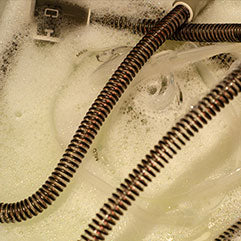
CPAP Maintenance: How To Clean Your CPAP Hose
A continuous positive airways pressure, or CPAP, machine is a precision medical device and should be treated with respect and care.
A CPAP machine is only available on prescription and should only be used according to the instructions of the doctor or health professional advising its use.
This means using the device as directed, taking good care of all the component parts and carrying out proper maintenance as required.
Cleanliness is crucial as the device can become blocked with microbes, dust particles and other airborne debris which can lead to a build-up of mold and bacteria in the tubing and mask.
Daily cleaning is not just recommended but necessary in order to avoid problems as well as ensure proper functioning and effectiveness of the CPAP machine.
Best Practices
The three components of a CPAP machine that require regular cleaning, maintenance or replacing are the:
- Mask
- Tubing
- Filters
It is the general consensus among experts that all three of these components should be replaced at least every three months and more often after illness or periods of above normal usage.
Cleaning these parts is best done with regular dishwasher’s soap or a recommended cleaning liquid.
Never use bleach, chlorine, moisturizing soap or alcohol-based cleaners as they may damage the parts, reduce the machine’s effectiveness or cause irritation to the skin or lungs.
Daily cleaning is best as it is easier than trying to remove debris and grease if it is allowed to build up over a period of time. It also ensures the CPAP machine is operating to maximum effect.
Cleaning guidelines for each component are:
Masks
A daily cleaning of the mask and mask cushion (which contacts the face) is advisable to ensure a proper seal. Use mild dish-washing soap mixed with warm water to rinse and clean and then allow the mask to air dry. A more thorough, rigorous cleaning should be carried out once a week and mask cushions should be replaced as recommended.
Tubing
Use a sink or basinful of warm water and mild dish-washing detergent to immerse and thoroughly clean the CPAP machine tubes. Continuously move and wash the tubing for around five minutes before rinsing off with clean water and allow to air dry on a towel rack, hanger or hook to ensure all excess water is removed from the tubes.
Filters
Run the filter under a warm tap for a few minutes before squeezing out excess water and blotting dry with a towel. Some CPAP machines have a “white filter” which is not meant to be washed but should be replaced after two weeks of use.
 Properly Cleaning CPAP tubing
Properly Cleaning CPAP tubing
Cleaning the CPAP tubing, or hose, is probably the most important task and the most complicated but it is, nonetheless, a relatively simple operation when done correctly. It is crucial that the air hose is thoroughly cleaned, dried and all impurities and bacteria removed.
There are three simple methods of achieving these targets:
Water
All CPAP tubing should be immersed in warm water containing a mild soap or cleaner at least once every seven days. The water should be agitated for 5 to 7 minutes to ensure all parts have been washed before the tubing is rinsed off with cold water and allowed to dry naturally. It is also a good idea to give the tubing a quick daily rinse with tap water to help maintain cleanliness.
Cleanser and Tube Brush
Various types of specifically designed CPAP tube cleansers and brushes are available. The tube brushes are made to fit the hose and can be bent to clean awkward areas and around bends. Cleansers can be scented, unscented and hypoallergenic as desired. Cleanser and brush systems reduce further any risk of bacteria or mold build-up in the air hose.
CPAP Cleaning Technology
To save time and effort, many people use a special CPAP cleaning device. The LiViliti Paptizer (available in our webstore) uses UV-C technology, which is used in medical settings and labs to kill germs in surfaces, the air, and in liquids.
With this cleaner, you can choose between 3 sanitizing options, depending on whether you want to use the equipment immediately after, keep it stored, or clean it and dry it. We like the drying option as well as the Fast Sanitizing cycle, which gets your device clean and ready to use in just 3 minutes.
The tubing in any CPAP machine can potentially become a breeding ground for bacteria if not maintained and cleaned regularly. The mask and air hose deliver the continuous air pressure required and defects in one or the other (or both) can not only result in diminished efficiency but also lead to illness because of exposure to harmful bacteria and viruses.
Other Maintenance Tips
Not all CPAP machines are the same. Some are simple devices while others are more complex. Regardless of the type of device, cleanliness is always the prime consideration.
If the CPAP machine has a humidifier this will also need cleaning at least once a week. Any water remaining in the tank should be removed and the chamber rinsed with warm soapy water. Rinse the tank thoroughly and allow to dry before it is returned to the machine. Humidifiers should also be disinfected every fourteen days using a five-part water to one part vinegar solution. Soak for thirty minutes, rinse and allow to dry before refilling with distilled water.
Always keep the CPAP machine and attachments out of direct sunlight.
Store the CPAP device on a solid, flat surface ensuring any air vents are kept clear of obstructions.
Keep track of when masks, mask cushions, filters and other supplies should be reordered and place orders in advance to avoid any downtime.
Regularly check hoses, connectors and tubing for cracks and signs of wear and tear. Replace any damaged or suspect attachments and accessories if in any doubt.
Proper cleaning and maintenance of the mask and tubing may be a chore but it is a necessary one in order to keep the CPAP machine performing smoothly, effectively and achieving the desired outcome which is a good night’s sleep!
Sources:
https://comprehensivesleepcare.com/cpap-cleaning-instructions/
https://www.sleepfoundation.org/cpap/how-to-clean-a-cpap-machine



